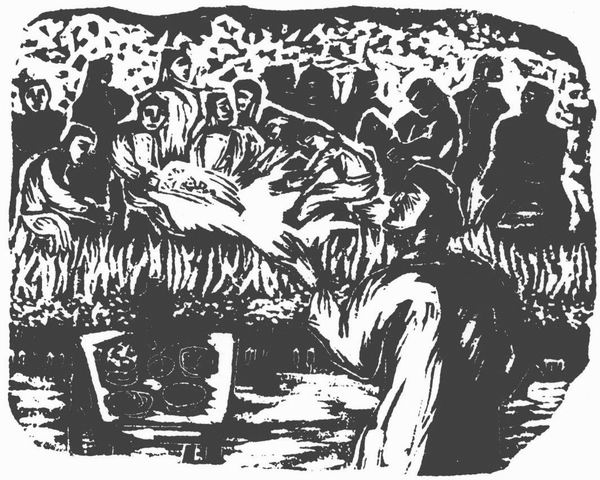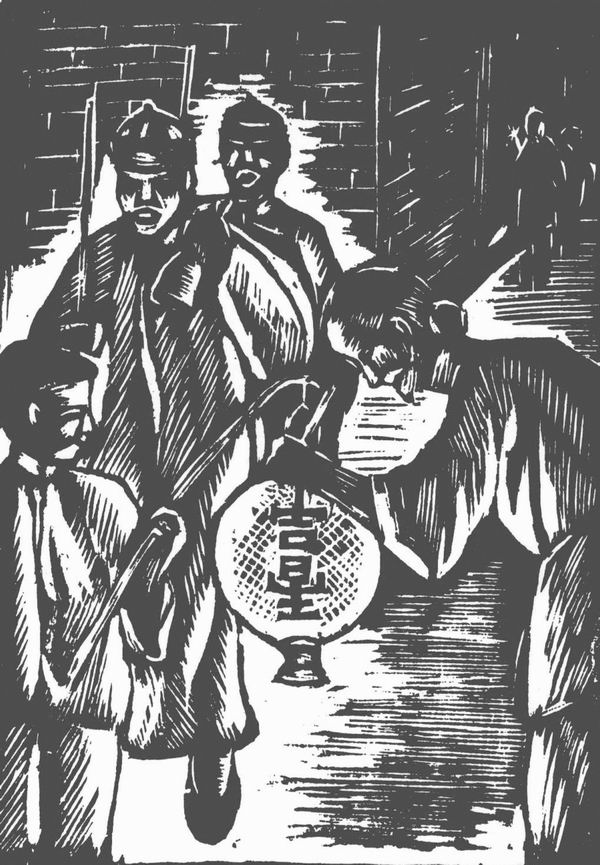Meet "Modernity" and "Tradition" —— Folk Customs in Modern Prints
The Guangzhou Modern Printmaking Conference, which was active in the mid-1930s, is of great significance in the history of modern art in Guangdong and even in China.Li Hua, the founder, recalled: "The historical significance of modern printmaking is that it is a stone in the huge building of the whole new woodcut movement."
The "White Bites Black —— Exhibition of the Collection of Modern Printmaking Club in the Emerging Woodblock Movement" sponsored by the Art Museum of Guangzhou Academy of Fine Arts recently opened. The exhibits are all selected from 146 original woodcuts of modern printmaking clubs found in the special collection of the college. These original works, which have gone through more than 80 years, are well preserved and have precious literature and artistic value. The exhibition is divided into two units: "Seize the bridgehead of modern art" and "Walk on the cross street of realism". "The Paper" was authorized to publish one of the special articles in the exhibition "Meet Modernity and Tradition-Folk Customs in Modern Prints".
Modern printmaking society devoted itself to creating "woodcuts loved by the public" at the beginning of its establishment. Naturally, folk customs and traditions became the source of inspiration for their woodcut creation. In the eighth episode of Modern Printmaking, published on May 1, 1935, the Modern Printmaking Conference once took "folk customs" as the special topic, and used the artistic language of woodcut to express the traditional customs all over the country.
Qixi Qiqiao Festival:

Liu Xian, Tanabata, color brush woodcut, first published in the eighth episode of Modern Prints, "Special Issue of Folk Customs"
Guanyin birthday:

Huang Peili, The Birthday of Guanyin, black and white woodcut, first published in the eighth episode of Modern Prints, "Special Issue of Folk Customs"
Burning clothes:

Pan Xuezhao, Burning Clothes, black and white woodcut, first published in the eighth episode of Modern Prints, "Special Issue of Folk Customs"
And common scenes in ancient TV dramas."Beware of fire candle":

Zhang Ying, "Beware of Fire Candles", black and white woodcut, first published in the eighth episode of Modern Prints, "Special Issue of Folk Customs"
And more are traditional customs that we have never heard of or seen before, such as:

Mei Ye, Bai Tanlang, black and white woodcut, first published in the eighth episode of Modern Prints, "Special Issue of Folk Customs"
Bye-bye:
"There is a saying in Guangzhou:’ A sandalwood tree, one heart’. In order to ensure that their husbands are not extroverted, women often tie their husbands’ trouser headband’ to a sandalwood tree privately and burn incense to pray, which is said to be quite effective. Because the Aralia pinnata is a tropical plant, although it is more than ten feet high, it has no branches, so women pray to men with this intention. At that time, many pieces of cloth were tied to the feet of Aralia elata trees inside and outside Guangzhou, which is why. "

Li Hua, crossing Xianqiao, black and white woodcut, first published in the eighth episode of Modern Prints, "Special Issue of Folk Customs"
Crossing the fairy bridge:
"In the funeral customs of Guangzhou and surrounding counties, if someone dies, you need to mourn for 49 days. Do it once every seven days, and invite nuns, monks or Taoist priests to recite the scriptures every other seven days. When chanting begins at around eight or nine o’clock in the evening, the first custom to be carried out is to’ cross the fairy bridge’-that is, to cross the meaning of ancestors from the Second Bridge of Gold and Silver to the Elysium. Crossing the Fairy Bridge was carried out by relatives and friends of the deceased, with the dutiful son supporting the coffin, the relatives holding banners and lanterns leading in front, and all the relatives and friends holding torches holding high, shining the night like a white book. The ceremonies of the funeral were completed step by step under the command of the reciter, and the whole ceremony was completed after the Second Bridge of Gold and Silver. Whether the family is poor or rich, this custom will still be used today. "

Liu Jinghui, Jing Jing, color brush woodcut, first published in the eighth episode of Modern Prints, "Special Issue of Folk Customs"
What a shock:
"This is a custom from Dongguan. They think that children get sick because they are fascinated by ghosts and gods. If the medicine doesn’t improve for several days, people will ask an old woman to "shock" the child. Old women will bring children’s daily clothes, incense sticks, incense sticks, food and fruit bait, as well as sharp tools such as scissors, to places where children often go, or corners of roads, tree feet and so on to summon souls. The old woman will recite incantations, display the children’s clothes on the fire, and’ sigh’ the children’s names frequently. The custom of’ stunned’ is still very popular in Guangzhou and nearby counties. "

Zhang Zaimin, Kitchen Horse, color brush woodcut, first published in the eighth episode of Modern Prints, "Special Issue of Folk Customs"
"This is a folk custom in Nanning, Guangxi. Every year, on the 23rd day of the twelfth lunar month, the Kitchen God is sent back to the Western Heaven. Besides offering sacrifices with various animals, people will also buy’ Kitchen Horses’ in the market and burn them in front of the Kitchen God. It means to send a horse to the kitchen god, so that the kitchen god can drive it to the west to convey the good things that have happened among the people. On the evening of the 30th of the twelfth lunar month, people will burn the’ kitchen horse’ again, which means that the kitchen god can ride the kitchen horse home for the New Year. The’ kitchen horse’ is all printed on paper, and there is an Xie stove sutra on it. The sutra says:’ The northern emperor is spiritual, and the six-year-old goddess makes sacrifices, which can be given priority to; The waters are full of incense lamps, and it is urgent to look up at the Linxuan and come to the kitchen. " "

Liang Yunxiang, Elder Brother, color brush woodcut, first published in the eighth episode of Modern Printmaking, "Special Issue of Folk Customs"
Elder brother:
"In July and August, there were worshippers of’ Elder Brother’ in Fujian custom:’ Elder Brother’ has one high and one low, the high one is called’ Big Brother’, and the short one is called’ Second Brother’. People wearing’ Elder Brother’ made of paper marched in the market, which can dispel the ominous atmosphere. At the same time, there will be children with shoulder straps and shackles standing on the street. When’ Brother’ passes by, they will kneel down to meet them. It is said that this will make children painless and painless. "

Zhang Zaimin, Burning Lion, black and white woodcut, first published in the eighth episode of Modern Prints, "Special Issue of Folk Customs"
Burning lion:
"On the first lunar month, there is a tradition of burning lions in Guangxi. It is believed that burning lions in Lantern Festival can avoid the plague for a year. The’ lion’ is made of bamboo, with thick paper covering the outside to make it look like a lion’s head, while the lion’s body and tail are made of five-color cloth. A person who is responsible for organizing lion dance in a martial arts school or temple. At that time, every family bought a string of firecrackers, and when the lion dance arrived at their door, people threw it at the lion dance with a string of firecrackers microphone. Although the lion dancers were shirtless, they let the firecrackers burn on themselves and kept spinning slowly. I heard that lion dancers will sweep their bodies with alum water in advance, so they can resist the attack of fireworks. "

Tang Yingwei, Master Qinglong, color brush woodcut, first published in the eighth episode of Modern Printmaking, "Special Issue of Folk Customs"
Master Qinglong:
"In modern civilized society, there is nothing more superstitious about ghosts and gods than Chaozhou worships green snakes. In the spring rain, the great green snake will come to Chaozhou, on the flooded Hanjiang River and in the torrential ditch water. Generally, good men and women will immediately pray and bow down to God when they see it, and then invite it to rest in the land temple in the neighborhood. At this time, the land temple can be turned into a gorgeous dragon palace at any time. According to legend, the Green Snake is the embodiment of Wang Kang of the Three Kingdoms. Whether this is the case remains to be confirmed. However, a few years ago, when Hong Zhaolin was in Chaozhou, he worshipped the Green Snake very much. Later, when he supervised the front line, he occasionally saw the Green Snake and won the battle. This is also a strange thing. Chaozhou people call the green snake’ Qinglong Ye’. "
In addition to recreating the folk customs at that time with woodcuts, members of the Modern Printmaking Society also published the Collection of Local Toys in South China and the Collection of Local Toys in North China in cooperation with the Japanese woodcut society "White and Black Society", and recorded these long-lost folk humor by means of chromatic woodcuts. At present, these two paintings are also on display at the scene.



Exhibition Name: White Bites Black —— Exhibition of the Collection of "Modern Printmaking Club" in the New Woodcutting Movement
Exhibition time: November 5th-November 27th.
Venue: Guangzhou Art Museum College Art Museum
(This article was originally published in WeChat WeChat official account, Art Museum of Guangzhou Academy of Fine Arts, and published by The Paper with authorization)